Aliband
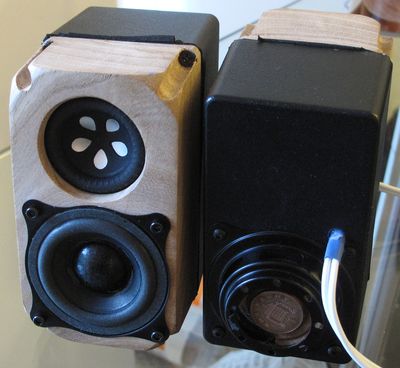
This design, in its final state at least, came after the SBBT, but also came before it throughout its various iterations. If you're familiar with the SBBT article you will know that it came about after some previous experimentation with the BF45 driver, from Visaton.
The project started with the BF45 and a yew front to the enclosure, a TPA3118 class D amplifier, from TI, and the RN52 Bluetooth module, from Microchip. This used the RN52s analogue outs, which while decent were nothing to get excited about.
After the modified electronics for the SBBT came about I also built second PCB for the BF45 design. This improved the performance of the first iteration immensely, not just in terms of battery life, but also due to the DSP capabilities of the TAS5756M. The speakers had only ever been used as nearfield monitors, to improve upon the sound of my Nexus 7 2013, when watching Netflix etc when lying in bed. Given their intended use higher SPLs, such as what the SBBT were capable of, didn't matter so using the DSP with a Linkwitz transform brought about a considerable improvement in sound quality due to now being able to extend the rather limited lower range of the BF45. Clearly this could not go very loud but for the most part this did not matter. Yes there was an apparent layer of low frequency distortion, due to pushing the driver quite hard, but the added warmth this lended to vocal reproduction was a trade off worth having.
Still, always aware of the systems overall limitations, I was always on the lookout for something that could replace the BF45. This had to be able to fit into the same cabinet, albeit with a different front, whilst reusing the electronics. It was obvious that if I wanted to improve on the BF45 in any significant way, that a ported, or passive radiator design was the only way forward. This approach had been taken by many designers before, such as with the Bose Soundlink mini, with decent success and it's easy to see why. Use an appropriately designed 1.5-2" driver in a tiny cabinet with PRs and you can expect to get extension down surprisingly low. In principle the idea is a good one but finding tiny drivers that are suitable for ported alignments is not easy. Bose obviously custom designed their drivers for the Soundlink mini and some cheap chinese knockoffs failed to impress. Both the quality control was appauling and the T/S parameters were completely unsuitable. Thankfuilly Tand Band, that good old war horse of tiny transducers, released a new range of drivers that were designed specifically for this application.
My eyes first landed on the W2-2136S but this was slightly too big to easily fit into the narrow cabinet so I decided to go with the W1-2121S. Ever so slightly smaller, but due to its higher Qts and identical fs, actually goes a tiny bit lower in a same sized cabinet but at the expense of some max SPL capability.
With the new driver sorted the hunt was on to find some suitable passive radiators. Square and rectangular PRs appear to be en vogue at the moment and you can find various examples littered around ebay, aliexpress and in various consumer products. It is easy to see why. Given that most products are rectangular in shape a rectangular PR, placed on the rear of a cabinet, makes good use of the space. Due to the position that the driver needed to be mounted and the location of the buttons/charging port a rectangular PR was out of the question so circular PRs were investigated. The choice was very small, but I chose the PRs pictured above. First and foremost they were almost the perfect size for the cabinet, so packed in the most surface area, but secondly they could also be mounted from the front amd from the rear. I wanted to be able to add in a second PR on the rear of the cabinet, incase one PR wasn't enough, and being able to mount the PR in reverse was important so as to keep the cabinet volume as high as possible, but also so that the basket of the driver could offer a degree of protection for the PR.
Measuring the driver in the pictured cabinet results in the frequency response shown below.
The project started with the BF45 and a yew front to the enclosure, a TPA3118 class D amplifier, from TI, and the RN52 Bluetooth module, from Microchip. This used the RN52s analogue outs, which while decent were nothing to get excited about.
After the modified electronics for the SBBT came about I also built second PCB for the BF45 design. This improved the performance of the first iteration immensely, not just in terms of battery life, but also due to the DSP capabilities of the TAS5756M. The speakers had only ever been used as nearfield monitors, to improve upon the sound of my Nexus 7 2013, when watching Netflix etc when lying in bed. Given their intended use higher SPLs, such as what the SBBT were capable of, didn't matter so using the DSP with a Linkwitz transform brought about a considerable improvement in sound quality due to now being able to extend the rather limited lower range of the BF45. Clearly this could not go very loud but for the most part this did not matter. Yes there was an apparent layer of low frequency distortion, due to pushing the driver quite hard, but the added warmth this lended to vocal reproduction was a trade off worth having.
Still, always aware of the systems overall limitations, I was always on the lookout for something that could replace the BF45. This had to be able to fit into the same cabinet, albeit with a different front, whilst reusing the electronics. It was obvious that if I wanted to improve on the BF45 in any significant way, that a ported, or passive radiator design was the only way forward. This approach had been taken by many designers before, such as with the Bose Soundlink mini, with decent success and it's easy to see why. Use an appropriately designed 1.5-2" driver in a tiny cabinet with PRs and you can expect to get extension down surprisingly low. In principle the idea is a good one but finding tiny drivers that are suitable for ported alignments is not easy. Bose obviously custom designed their drivers for the Soundlink mini and some cheap chinese knockoffs failed to impress. Both the quality control was appauling and the T/S parameters were completely unsuitable. Thankfuilly Tand Band, that good old war horse of tiny transducers, released a new range of drivers that were designed specifically for this application.
My eyes first landed on the W2-2136S but this was slightly too big to easily fit into the narrow cabinet so I decided to go with the W1-2121S. Ever so slightly smaller, but due to its higher Qts and identical fs, actually goes a tiny bit lower in a same sized cabinet but at the expense of some max SPL capability.
With the new driver sorted the hunt was on to find some suitable passive radiators. Square and rectangular PRs appear to be en vogue at the moment and you can find various examples littered around ebay, aliexpress and in various consumer products. It is easy to see why. Given that most products are rectangular in shape a rectangular PR, placed on the rear of a cabinet, makes good use of the space. Due to the position that the driver needed to be mounted and the location of the buttons/charging port a rectangular PR was out of the question so circular PRs were investigated. The choice was very small, but I chose the PRs pictured above. First and foremost they were almost the perfect size for the cabinet, so packed in the most surface area, but secondly they could also be mounted from the front amd from the rear. I wanted to be able to add in a second PR on the rear of the cabinet, incase one PR wasn't enough, and being able to mount the PR in reverse was important so as to keep the cabinet volume as high as possible, but also so that the basket of the driver could offer a degree of protection for the PR.
Measuring the driver in the pictured cabinet results in the frequency response shown below.
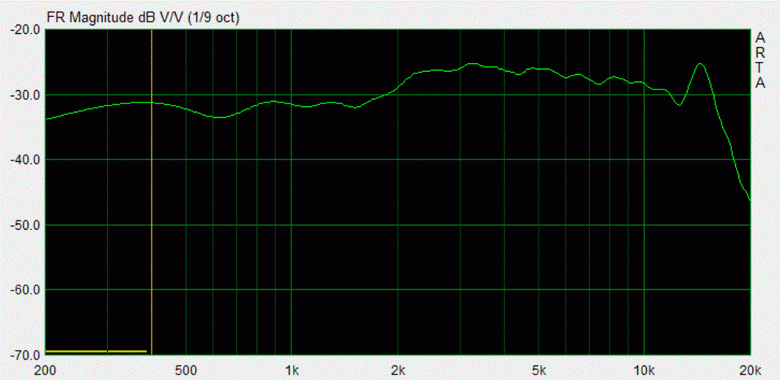
Thankfully there were no surprises here. Tang Band are known for fudging their frequency responses, so it was nice to see that this is not one of those cases. The driver has decent high frequency extension, only missing the very last few kHz from the top octave. A mild amount of cone breakup is present although it is very well controlled. Nothing out of the ordinary to see with the obvious losses from baffle step causing the response to fall away towards low frequencies. As the electronics are the same as the SBBT a simple shelving filter is easy to implement to correct for this.
When looking at pictures of the 2121S the way cone is constructed isn't readily apparent. Before buying I had anticipated that the cone was anodised black with some silver spots added for cosmetic effect, this couldn't have been further from the truth. The silver spots are actually polished aluminium and are the only visible parts of the metal cone itself, the black happens to be a coating of rubber that is applied on top of the cone. As the bell mode resonance of the cone is very mild I am assuming that the rubber is responsible for keeping it under control. Running a distortion measurement of the driver helped to confirm this.
When looking at pictures of the 2121S the way cone is constructed isn't readily apparent. Before buying I had anticipated that the cone was anodised black with some silver spots added for cosmetic effect, this couldn't have been further from the truth. The silver spots are actually polished aluminium and are the only visible parts of the metal cone itself, the black happens to be a coating of rubber that is applied on top of the cone. As the bell mode resonance of the cone is very mild I am assuming that the rubber is responsible for keeping it under control. Running a distortion measurement of the driver helped to confirm this.
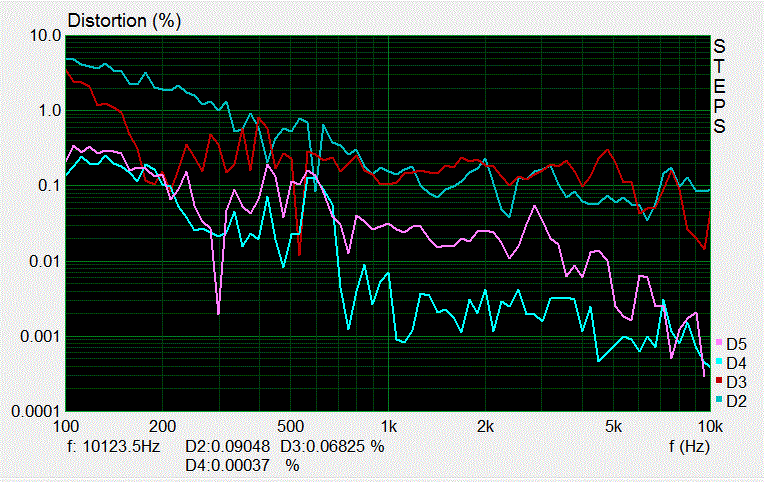
With metal cones what is usually seen is distortion amplification due to the cones resonance at exact divisions in the harmonic distortion measurements at those divisions below the fundamental. In other words lets say the cone resonates at 9kHz, if you feed a 3kHz signal to the driver its motor will generate a 3rd harmonic at 9kHz, because the cone also rings at this frequency the cone resonance will amplify the distortion product. Here though we cannot see any dramatic evidence of this. Yes there are small peaks in the 3rd and 5th harmonics but nothing that would cause you to dismiss the driver.
Indeed the performance is really very good. The only real fly in the ointment is the increase in tall order harmonics between 300 and 700Hz. This is something to watch out for because it was caused by the driver's frame resonating against the wooden enclosure. The W1-2121S does not have any of the usual methods for mounting. As can be seen from Tang Band's own pictures the rubber ring that secures the half roll surround protrudes every so slightly from the moulded plastic basket. I figured that the best way to mount the driver would be to use this rubber ring to seal the driver into the cabinet from behind. This was a good idea but for a perfect fit the driver needs to have pressure applied from behind to prevent it from vibrating against the cabinet at certain frequencies. This isn't the end of the world but if you want to mount the driver for the best perforomance this is what you need to do.
The degree to which this problem manifests is related entirely to how hard you push the driver. In the above measurement I performed it at 2V RMS. As the driver is 4 ohms this results in about 79dB from the driver, this is quite loud. Most of the time I actually listen to them at a much lower volume and at about 30-40cm distance away, so felt a 1 watt drive level was fairly appropriate given their end use.
Given the drivers inherent linearity the only thing necessary, from a crossover point of view, was to compensate for baffle step with the tuning of the passive radiators the only thing left. As bought from aliexpress they came with no specifications so were a completely unknown quantity.
Indeed the performance is really very good. The only real fly in the ointment is the increase in tall order harmonics between 300 and 700Hz. This is something to watch out for because it was caused by the driver's frame resonating against the wooden enclosure. The W1-2121S does not have any of the usual methods for mounting. As can be seen from Tang Band's own pictures the rubber ring that secures the half roll surround protrudes every so slightly from the moulded plastic basket. I figured that the best way to mount the driver would be to use this rubber ring to seal the driver into the cabinet from behind. This was a good idea but for a perfect fit the driver needs to have pressure applied from behind to prevent it from vibrating against the cabinet at certain frequencies. This isn't the end of the world but if you want to mount the driver for the best perforomance this is what you need to do.
The degree to which this problem manifests is related entirely to how hard you push the driver. In the above measurement I performed it at 2V RMS. As the driver is 4 ohms this results in about 79dB from the driver, this is quite loud. Most of the time I actually listen to them at a much lower volume and at about 30-40cm distance away, so felt a 1 watt drive level was fairly appropriate given their end use.
Given the drivers inherent linearity the only thing necessary, from a crossover point of view, was to compensate for baffle step with the tuning of the passive radiators the only thing left. As bought from aliexpress they came with no specifications so were a completely unknown quantity.
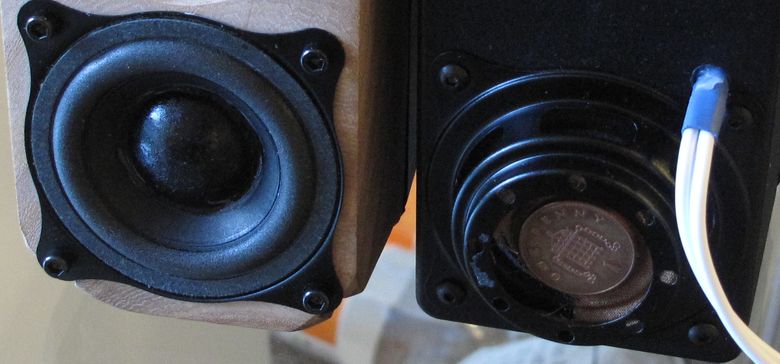
With PRs less is never equal to more in that you can never have enough surface area. Initially I did try out using one PR but ended up going for two. The rear mounted one helps to provide at degree of force cancellation and even if not particularly significant, some is still better than none.
If you happen to see these PRs on aliexpress you will notice that their dustcaps aren't as shiny as mine. Indeed the paper cap is rather easy to squash in so I gave them a few coats of super glue in an attempt to stiffen them up, this worked rather well.
As people familiar with PRs know the frequency to which they are tuned is determined by the mass of the move parts. Measuring the impedance of the loudspeaker revealed that extra mass was required to tune these lower than the inherent frequency reached with the PRs natural moving mass. It just so happened that adding a the weight of a penny to each PR worked out pretty well.
If you happen to see these PRs on aliexpress you will notice that their dustcaps aren't as shiny as mine. Indeed the paper cap is rather easy to squash in so I gave them a few coats of super glue in an attempt to stiffen them up, this worked rather well.
As people familiar with PRs know the frequency to which they are tuned is determined by the mass of the move parts. Measuring the impedance of the loudspeaker revealed that extra mass was required to tune these lower than the inherent frequency reached with the PRs natural moving mass. It just so happened that adding a the weight of a penny to each PR worked out pretty well.
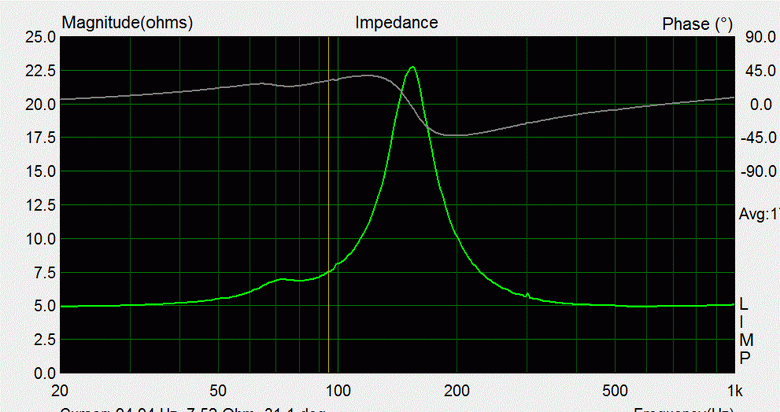
Above is the measured impedance showing the tuning frequency of around 95Hz. Below is a near field measurement giving an appoximation as to the actual low frequency response.
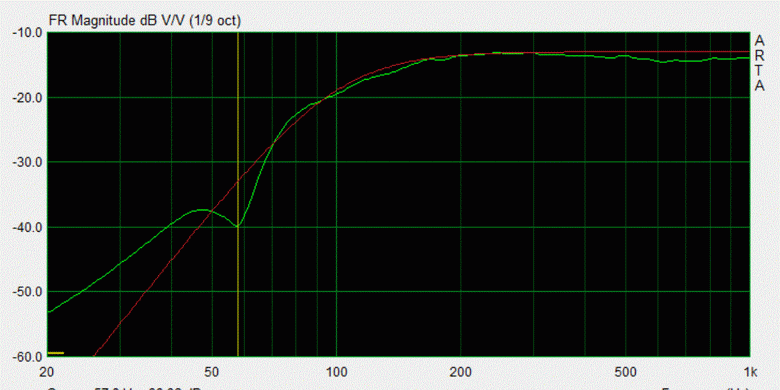
I say approximation in this case because the contribution from the rear mounted PR wont have been captured particularly accurately but it does give a decent impression of what can be expected, albeit with a little more output in the 80-90Hz region for the finished loudspeaker. The red overlay is a 4th order Linkwitz Riley slope at 100Hz. This isn't too different from the EQd bass target of the SBBT. Not bad for such a tiny little driver.
It should be noted here that the PRs have a rather stiff suspension, indeed most of the rectangular type PRs included in small bluetooth loudspeakers don't include any spirder at all and simply make do with the surround. The stiffness lowers the mechanical Q of the PR and acts to reduce its output at the tuning frequency. This can be seen by the shallow roll off in the near field response but also in the magnitude of the first bump in the impedance plot. Reducing the stifness of the PRs suspension will increase the PRs output and also increase the magnitude of the first impedance bump.
Accomplishing this can be done by cutting away sections of the spider, or by removing the spider completely. Those with keen eyes will notice that I have already removed roughly half of the spider in the picture above. Given simulations in LspCAD it looks like it should be possible to end up with a response that looks close to this.
It should be noted here that the PRs have a rather stiff suspension, indeed most of the rectangular type PRs included in small bluetooth loudspeakers don't include any spirder at all and simply make do with the surround. The stiffness lowers the mechanical Q of the PR and acts to reduce its output at the tuning frequency. This can be seen by the shallow roll off in the near field response but also in the magnitude of the first bump in the impedance plot. Reducing the stifness of the PRs suspension will increase the PRs output and also increase the magnitude of the first impedance bump.
Accomplishing this can be done by cutting away sections of the spider, or by removing the spider completely. Those with keen eyes will notice that I have already removed roughly half of the spider in the picture above. Given simulations in LspCAD it looks like it should be possible to end up with a response that looks close to this.
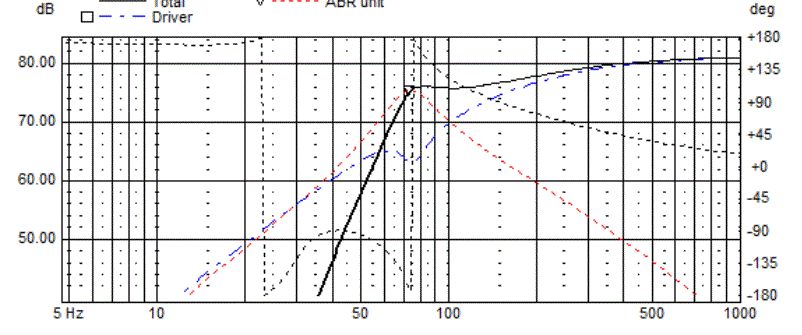
Doing so would increase bass efficiency and provide useful extension down to around 70Hz. This is certainly an attractive proposition but once removed the spider cannot be put back and the speakers already sound extremely impressive as they are.
This gives some room for possible improvement at some point in the future, but for now I am quite happy to leave them just as they are.
This gives some room for possible improvement at some point in the future, but for now I am quite happy to leave them just as they are.